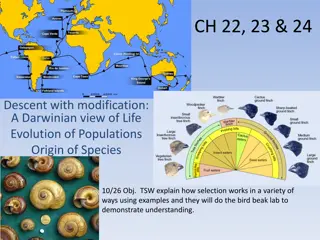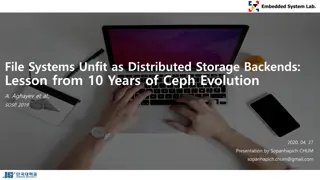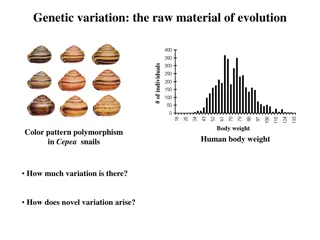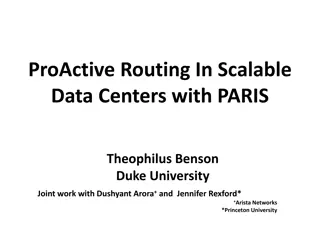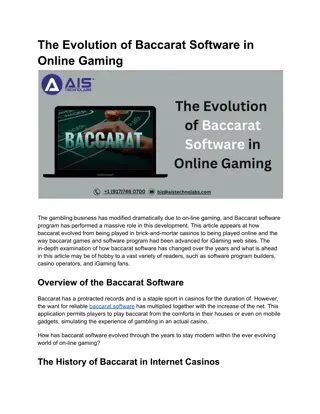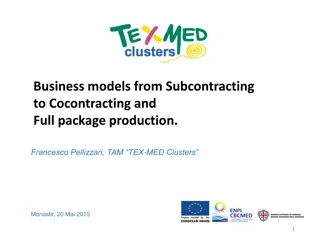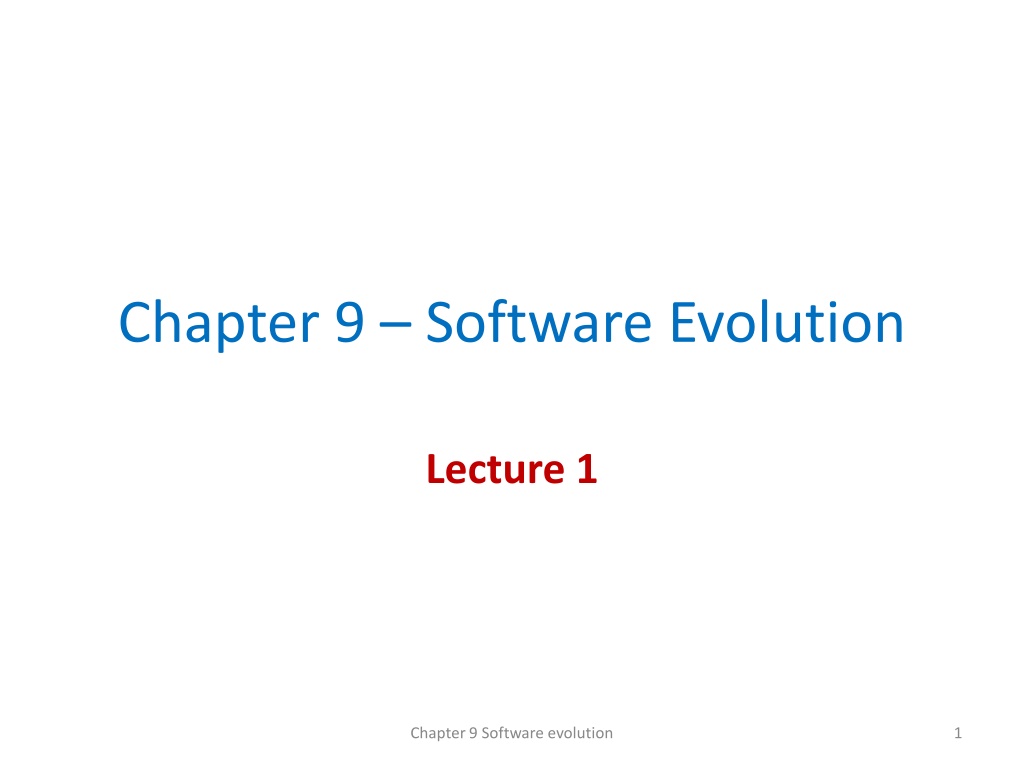
Understanding Software Evolution and Change Processes
Explore the importance of software evolution, the inevitability of software changes, and the key processes involved in the evolution and servicing of software systems. Learn about maintaining and updating critical business assets through software evolution to meet new requirements and adapt to changing environments.
Download Presentation

Please find below an Image/Link to download the presentation.
The content on the website is provided AS IS for your information and personal use only. It may not be sold, licensed, or shared on other websites without obtaining consent from the author. Download presentation by click this link. If you encounter any issues during the download, it is possible that the publisher has removed the file from their server.
E N D
Presentation Transcript
Chapter 9 Software Evolution Lecture 1 Chapter 9 Software evolution 1
Topics covered Evolution processes Change processes for software systems Program evolution dynamics Understanding software evolution Software maintenance Making changes to operational software systems Legacy system management Making decisions about software change Chapter 9 Software evolution 2
Software change Software change is inevitable New requirements emerge when the software is used; The business environment changes; Errors must be repaired; New computers and equipment is added to the system; The performance or reliability of the system may have to be improved. A key problem for all organizations is implementing and managing change to their existing software systems. Chapter 9 Software evolution 3
Importance of evolution Organizations have huge investments in their software systems - they are critical business assets. To maintain the value of these assets to the business, they must be changed and updated. The majority of the software budget in large companies is devoted to changing and evolving existing software rather than developing new software. Chapter 9 Software evolution 4
A spiral model of development and evolution Chapter 9 Software evolution 5
Evolution and servicing Chapter 9 Software evolution 6
Evolution and servicing Evolution The stage in a software system s life cycle where it is in operational use and is evolving as new requirements are proposed and implemented in the system. Servicing At this stage, the software remains useful but the only changes made are those required to keep it operational i.e. bug fixes and changes to reflect changes in the software s environment. No new functionality is added. Phase-out The software may still be used but no further changes are made to it. Chapter 9 Software evolution 7
Evolution processes Software evolution processes depend on The type of software being maintained; The development processes used; The skills and experience of the people involved. Proposals for change are the driver for system evolution. Should be linked with components that are affected by the change, thus allowing the cost and impact of the change to be estimated. Change identification and evolution continues throughout the system lifetime. Chapter 9 Software evolution 8
Change identification and evolution processes Chapter 9 Software evolution 9
The software evolution process Chapter 9 Software evolution 10
Change implementation Chapter 9 Software evolution 11
Change implementation Iteration of the development process where the revisions to the system are designed, implemented and tested. A critical difference is that the first stage of change implementation may involve program understanding, especially if the original system developers are not responsible for the change implementation. During the program understanding phase, you have to understand how the program is structured, how it delivers functionality and how the proposed change might affect the program. Chapter 9 Software evolution 12
Urgent change requests Urgent changes may have to be implemented without going through all stages of the software engineering process If a serious system fault has to be repaired to allow normal operation to continue; If changes to the system s environment (e.g. an OS upgrade) have unexpected effects; If there are business changes that require a very rapid response (e.g. the release of a competing product). Chapter 9 Software evolution 13
The emergency repair process Chapter 9 Software evolution 14
Agile methods and evolution Agile methods are based on incremental development so the transition from development to evolution is a seamless one. Evolution is simply a continuation of the development process based on frequent system releases. Automated regression testing is particularly valuable when changes are made to a system. Changes may be expressed as additional user stories. Chapter 9 Software evolution 15
Handover problems Where the development team have used an agile approach but the evolution team is unfamiliar with agile methods and prefer a plan-based approach. The evolution team may expect detailed documentation to support evolution and this is not produced in agile processes. Where a plan-based approach has been used for development but the evolution team prefer to use agile methods. The evolution team may have to start from scratch developing automated tests and the code in the system may not have been refactored and simplified as is expected in agile development. Chapter 9 Software evolution 16
Program evolution dynamics Program evolution dynamics is the study of the processes of system change. After several major empirical studies, Lehman and Belady proposed that there were a number of laws which applied to all systems as they evolved. There are sensible observations rather than laws. They are applicable to large systems developed by large organisations. It is not clear if these are applicable to other types of software system. Chapter 9 Software evolution 17
Change is inevitable The system requirements are likely to change while the system is being developed because the environment is changing. Therefore a delivered system won't meet its requirements! Systems are tightly coupled with their environment. When a system is installed in an environment it changes that environment and therefore changes the system requirements. Systems MUST be changed if they are to remain useful in an environment. Chapter 9 Software evolution 18
Lehmans laws Law Description Continuing change A program that is used in a real-world environment must necessarily change, or else become progressively less useful in that environment. Increasing complexity As an evolving program changes, its structure tends to become more complex. Extra resources must be devoted to preserving and simplifying the structure. Large program evolution Program evolution is a self-regulating process. System attributes such as size, time between releases, and the number of reported errors is approximately invariant for each system release. Organizational stability Over a program s lifetime, its rate of development is approximately constant and independent of the resources devoted to system development. Chapter 9 Software evolution 19
Lehmans laws Law Conservation of familiarity Description Over the lifetime of a system, the incremental change in each release is approximately constant. Continuing growth The functionality offered by systems has to continually increase to maintain user satisfaction. Declining quality The quality of systems will decline unless they are modified to reflect changes in their operational environment. Feedback system Evolution processes incorporate multiagent, multiloop feedback systems and you have to treat them as feedback systems to achieve significant product improvement. Chapter 9 Software evolution 20
Applicability of Lehmans laws Lehman s laws seem to be generally applicable to large, tailored systems developed by large organisations. Confirmed in early 2000 s by work by Lehman on the FEAST project. It is not clear how they should be modified for Shrink-wrapped software products; Systems that incorporate a significant number of COTS components; Small organisations; Medium sized systems. Chapter 9 Software evolution 21
Key points Software development and evolution can be thought of as an integrated, iterative process that can be represented using a spiral model. For custom systems, the costs of software maintenance usually exceed the software development costs. The process of software evolution is driven by requests for changes and includes change impact analysis, release planning and change implementation. Lehman s laws, such as the notion that change is continuous, describe a number of insights derived from long-term studies of system evolution. Chapter 9 Software evolution 22
Chapter 9 Software Evolution Lecture 2 Chapter 9 Software evolution 23
Software maintenance Modifying a program after it has been put into use. The term is mostly used for changing custom software. Generic software products are said to evolve to create new versions. Maintenance does not normally involve major changes to the system s architecture. Changes are implemented by modifying existing components and adding new components to the system. Chapter 9 Software evolution 24
Types of maintenance Maintenance to repair software faults Changing a system to correct deficiencies in the way meets its requirements. Maintenance to adapt software to a different operating environment Changing a system so that it operates in a different environment (computer, OS, etc.) from its initial implementation. Maintenance to add to or modify the system s functionality Modifying the system to satisfy new requirements. Chapter 9 Software evolution 25
Figure 9.8 Maintenance effort distribution Chapter 9 Software evolution 26
Maintenance costs Usually greater than development costs (2* to 100* depending on the application). Affected by both technical and non-technical factors. Increases as software is maintained. Maintenance corrupts the software structure so makes further maintenance more difficult. Ageing software can have high support costs (e.g. old languages, compilers etc.). Chapter 9 Software evolution 27
Figure 9.9 Development and maintenance costs Chapter 9 Software evolution 28
Maintenance cost factors Team stability Maintenance costs are reduced if the same staff are involved with them for some time. Contractual responsibility The developers of a system may have no contractual responsibility for maintenance so there is no incentive to design for future change. Staff skills Maintenance staff are often inexperienced and have limited domain knowledge. Program age and structure As programs age, their structure is degraded and they become harder to understand and change. Chapter 9 Software evolution 29
Maintenance prediction Maintenance prediction is concerned with assessing which parts of the system may cause problems and have high maintenance costs Change acceptance depends on the maintainability of the components affected by the change; Implementing changes degrades the system and reduces its maintainability; Maintenance costs depend on the number of changes and costs of change depend on maintainability. Chapter 9 Software evolution 30
Maintenance prediction Chapter 9 Software evolution 31
Change prediction Predicting the number of changes requires and understanding of the relationships between a system and its environment. Tightly coupled systems require changes whenever the environment is changed. Factors influencing this relationship are Number and complexity of system interfaces; Number of inherently volatile system requirements; The business processes where the system is used. Chapter 9 Software evolution 32
Complexity metrics Predictions of maintainability can be made by assessing the complexity of system components. Studies have shown that most maintenance effort is spent on a relatively small number of system components. Complexity depends on Complexity of control structures; Complexity of data structures; Object, method (procedure) and module size. Chapter 9 Software evolution 33
Process metrics Process metrics may be used to assess maintainability Number of requests for corrective maintenance; Average time required for impact analysis; Average time taken to implement a change request; Number of outstanding change requests. If any or all of these is increasing, this may indicate a decline in maintainability. Chapter 9 Software evolution 34
System re-engineering Re-structuring or re-writing part or all of a legacy system without changing its functionality. Applicable where some but not all sub-systems of a larger system require frequent maintenance. Re-engineering involves adding effort to make them easier to maintain. The system may be re- structured and re-documented. Chapter 9 Software evolution 35
Advantages of reengineering Reduced risk There is a high risk in new software development. There may be development problems, staffing problems and specification problems. Reduced cost The cost of re-engineering is often significantly less than the costs of developing new software. Chapter 9 Software evolution 36
The reengineering process Chapter 9 Software evolution 37
Reengineering process activities Source code translation Convert code to a new language. Reverse engineering Analyse the program to understand it; Program structure improvement Restructure automatically for understandability; Program modularisation Reorganise the program structure; Data reengineering Clean-up and restructure system data. Chapter 9 Software evolution 38
Figure 9.12 Reengineering approaches Chapter 9 Software evolution 39
Reengineering cost factors The quality of the software to be reengineered. The tool support available for reengineering. The extent of the data conversion which is required. The availability of expert staff for reengineering. This can be a problem with old systems based on technology that is no longer widely used. Chapter 9 Software evolution 40
Preventative maintenance by refactoring Refactoring is the process of making improvements to a program to slow down degradation through change. You can think of refactoring as preventative maintenance that reduces the problems of future change. Refactoring involves modifying a program to improve its structure, reduce its complexity or make it easier to understand. When you refactor a program, you should not add functionality but rather concentrate on program improvement. Chapter 9 Software evolution 41
Refactoring and reengineering Re-engineering takes place after a system has been maintained for some time and maintenance costs are increasing. You use automated tools to process and re-engineer a legacy system to create a new system that is more maintainable. Refactoring is a continuous process of improvement throughout the development and evolution process. It is intended to avoid the structure and code degradation that increases the costs and difficulties of maintaining a system. Chapter 9 Software evolution 42
Bad smells in program code Duplicate code The same or very similar code may be included at different places in a program. This can be removed and implemented as a single method or function that is called as required. Long methods If a method is too long, it should be redesigned as a number of shorter methods. Switch (case) statements These often involve duplication, where the switch depends on the type of a value. The switch statements may be scattered around a program. In object-oriented languages, you can often use polymorphism to achieve the same thing. Chapter 9 Software evolution 43
Bad smells in program code Data clumping Data clumps occur when the same group of data items (fields in classes, parameters in methods) re-occur in several places in a program. These can often be replaced with an object that encapsulates all of the data. Speculative generality This occurs when developers include generality in a program in case it is required in the future. This can often simply be removed. Chapter 9 Software evolution 44
Legacy system management Organisations that rely on legacy systems must choose a strategy for evolving these systems Scrap the system completely and modify business processes so that it is no longer required; Continue maintaining the system; Transform the system by re-engineering to improve its maintainability; Replace the system with a new system. The strategy chosen should depend on the system quality and its business value. Chapter 9 Software evolution 45
Figure 9.13 An example of a legacy system assessment Chapter 9 Software evolution 46
Legacy system categories Low quality, low business value These systems should be scrapped. Low-quality, high-business value These make an important business contribution but are expensive to maintain. Should be re-engineered or replaced if a suitable system is available. High-quality, low-business value Replace with COTS, scrap completely or maintain. High-quality, high business value Continue in operation using normal system maintenance. Chapter 9 Software evolution 47
Business value assessment Assessment should take different viewpoints into account System end-users; Business customers; Line managers; IT managers; Senior managers. Interview different stakeholders and collate results. Chapter 9 Software evolution 48
Issues in business value assessment The use of the system If systems are only used occasionally or by a small number of people, they may have a low business value. The business processes that are supported A system may have a low business value if it forces the use of inefficient business processes. System dependability If a system is not dependable and the problems directly affect business customers, the system has a low business value. The system outputs If the business depends on system outputs, then the system has a high business value. Chapter 9 Software evolution 49
System quality assessment Business process assessment How well does the business process support the current goals of the business? Environment assessment How effective is the system s environment and how expensive is it to maintain? Application assessment What is the quality of the application software system? Chapter 9 Software evolution 50




